Introduction:
Hello, my friends – I’m back with another review, and this time I’m taking a look at Prevail Key Company’s latest linear switch offering, the Nebula. This one’s un-sponsored; I was curious about these, bought some for myself, and decided to share my thoughts here after a few weeks with them in my daily keeb. Let’s get into it!
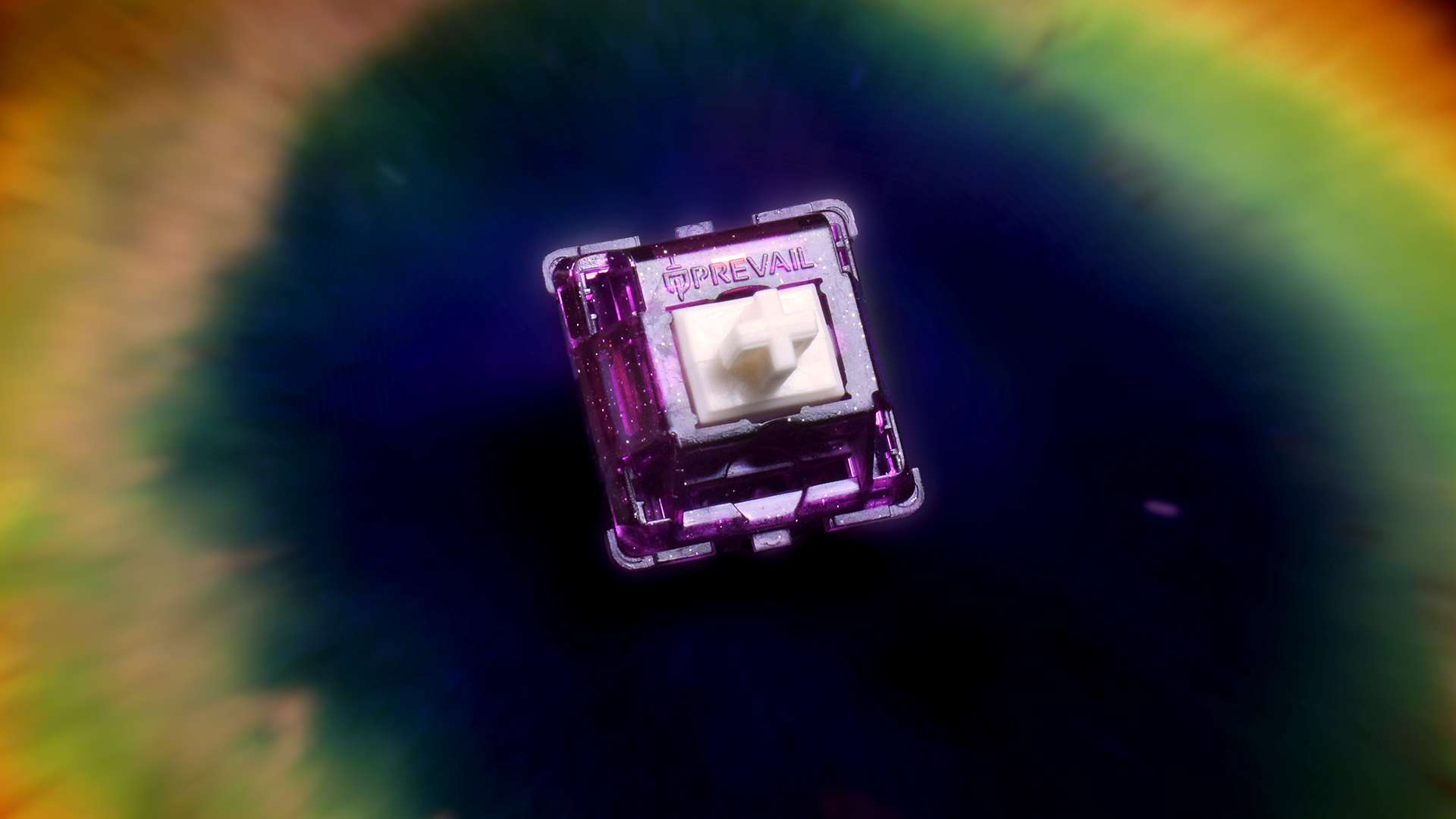
Ooh, pretty.
The Basics:
- Type: Linear
- Sub-types: Long-pole, Progressive
- Brand: Prevail Key Co. (with Cobertt of Control On Caps)
- Manufacturer: JWK
- Housing: full Nylon (PA)
- Stem: Custom mold, “LY” material*
- Spring weight: 62g**
- Factory lube: “light”
- Mounting: PCB / 5-pin
*I’ve reached out to Prevail for a little more info about what kind of plastic “LY” might be; I haven’t heard back as of writing, but will update with more information as I have it.
**I don’t currently have a force-curve graph or discrete measurements of starting, actuation, and bottom-out weights. IC’s listed the weight at 67g, sales pages list at 62g. I’ll update this review with that information as able.
Context & Background:
Originally announced with an Interest-Check post in mid-December of 2020, the Nebula switch has taken a long if not terribly winding road from there into the hands and keyboards of consumers. A collaboration between established builder Cobertt of Control On Caps and respected vendor Prevail Key Co., the Nebula switch had its sights set on being a smooth, clacky, progressive long-pole linear – a category with scant representation among stock commercial options.
Discussion around the IC mentioned that full-Nylon from JWK was exclusive to Cannon Keys, but by the time the GB rolled around, full-Nylon was all-systems-go for the Nebulae.
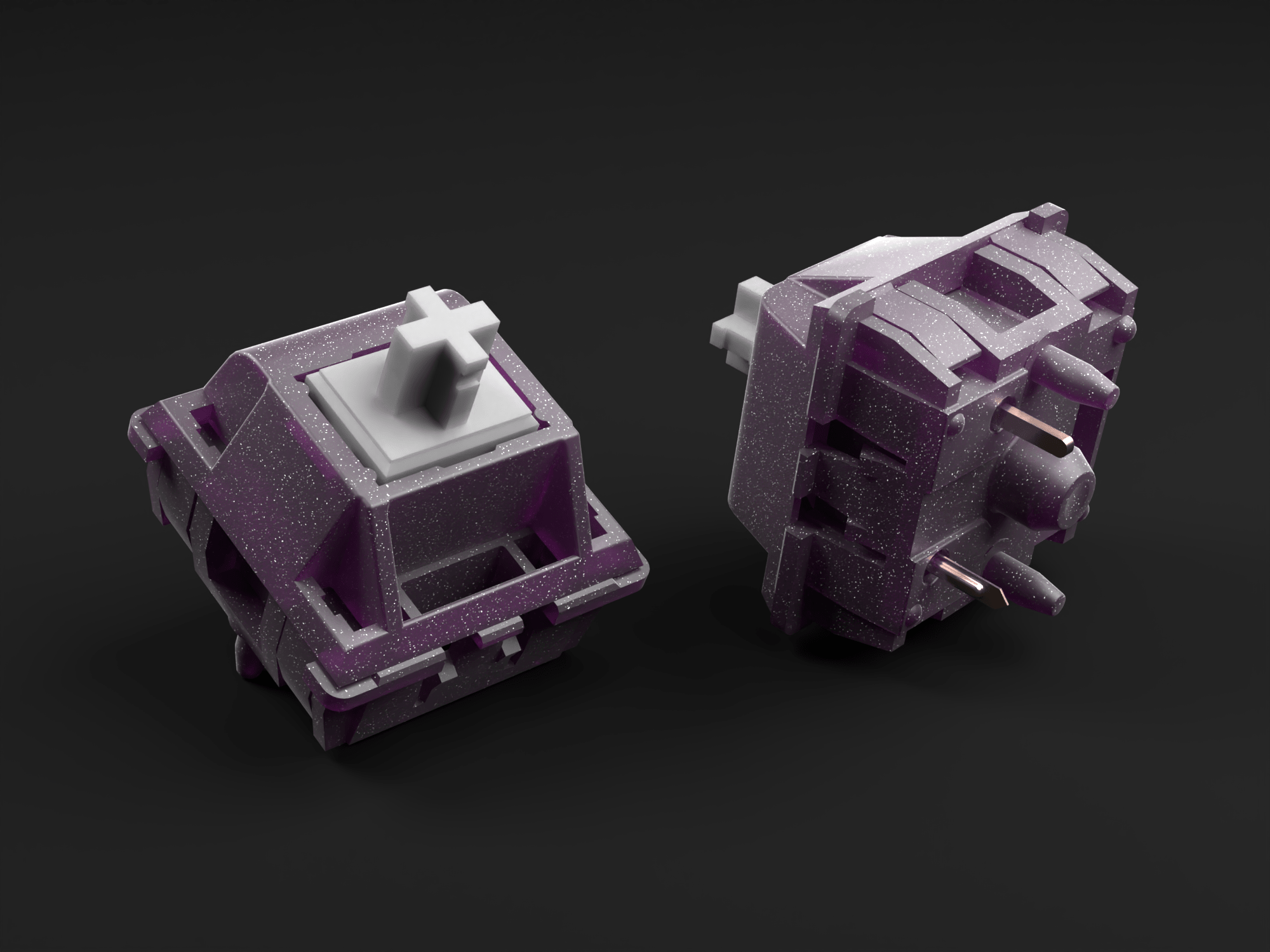
Original render from the Nebula Interest Check post on Geekhack
At the time of its announcement nearly two years ago, the progressive linear segment was vanishingly small – and it’s not very different today. Off-hand, I can only think of two others that actually made it to production: the ThicThock Marshmallow (also made by JWK, with springs hand-installed at the factory), and the NK_ Cream Arc (made by Kailh, no clue about the springs there). At one time, TKC’s Dragonfruit switch was planned as a progressive linear, but the idea was abandoned for an Ergo Clear style tactile instead when it became clear manually-oriented springs would mean a price increase they weren’t happy with. Ever since TKC announced that change, I’d been hoping for other factory progressives to hit the market, so I was naturally excited by the announcement of this switch – and unlike TKC’s, this one made it to market almost completely unchanged from its initial plan.
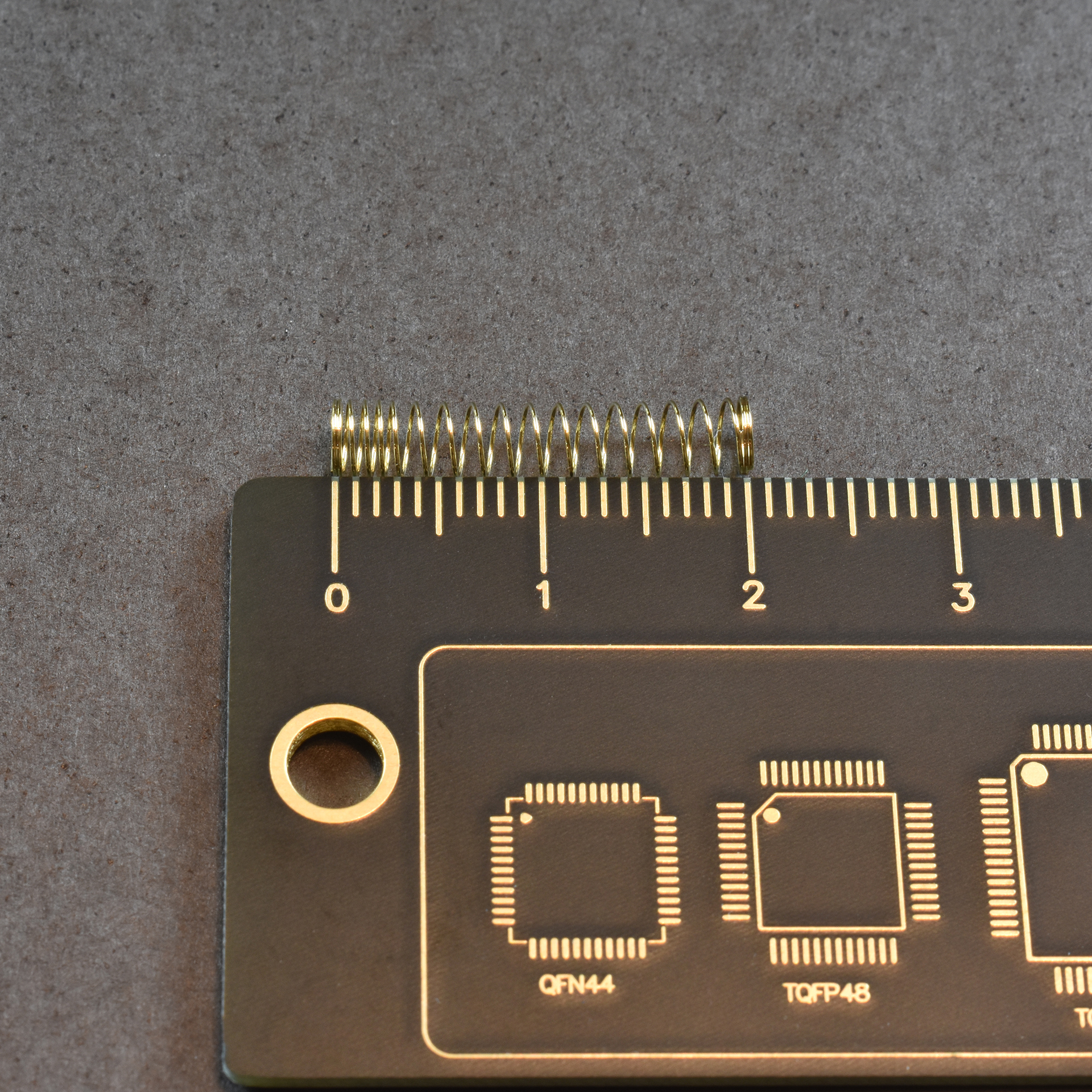
The Nebula’s core, a roughly 20mm progressive spring. On the left side, there’s about 4mm worth of tighter coiling.
If you’re not familiar, a “progressive” spring is one whose *rate* of rising resistance increases with compression. That is, the more the spring is compressed, the faster the resistance increases per unit of compression. All springs increase in resistance (usually just called “weight” in the keeb hobby) as they are compressed, but the amount of weight increase per unit of compression is generally the same throughout compression. Some springs increase in weight only slightly when compressed (called “slow curve”), others more dramatically (called “fast curve”) – but both of those fall under the “linear” spring category – plotted on a resistance/compression graph (called a “force curve graph”), the data would appear as a straight line; shallow, steep, or somewhere in between. However, a “progressive” spring will produce a *curved* line on the very same graph, increasing in steepness with compression.

Automotive spring graph from the iRacing forums illustrating the difference between a progressive spring rate (left) and a linear one (right).
The nature, efficacy, and character of progressive springs is its own multi-pronged discussion, still fairly rich with debate to this day – so I’ll avoid getting into those weeds for the moment. For now, I’ll carve-out this detail for today’s discussion:
Marshmallow switches cost more than originally planned thanks to hand-installation of the springs at the factory. Dragonfruit switches got turned into something else completely in lieu of raising the price or suffering inconsistency. When I asked Prevail if spring orientation could be a factor for these switches, the initial response was yes, due to the tighter coil at one end. I mis-remembered this as meaning the spring would be conical, which actually would make the orientation matter – but I think they were just talking about pitch.
There’s all kinds of debate about whether cylindrical progressive springs behave differently depending on their orientation inside the switch, with most evidence leaning towards it making no difference – *however* – that story changes when the top and bottom of the spring aren’t the same shape, and may not be interacting with identically-shaped surfaces at either end inside the switch. That is, with a conical spring, orientation *may indeed* matter because the pre-load compression may be different depending on that orientation because of the surfaces the spring seats into / onto.
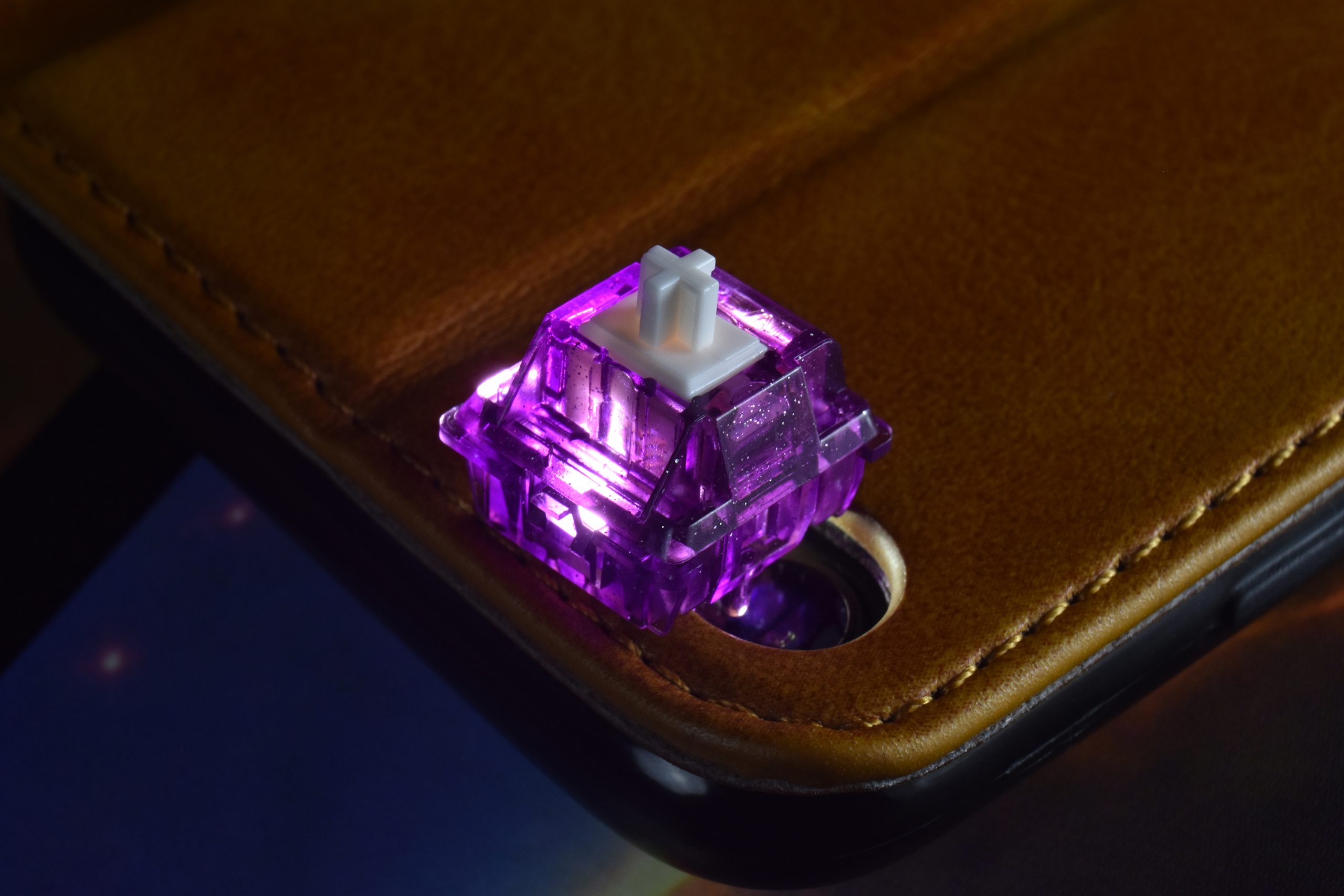
No specific reason this photo is here, I just thought it looked cool.
That confirmation was two years ago, though – and while a surprising number of details have remained unchanged since that time, the one about spring orientation hasn’t. From what I can gather, the story now goes like this:
Prevail decided against using hand-installation of the springs to avoid a price increase, but also decided to stick with the progressive springs, being a core part of the idea behind them. Apparently they determined that with the spring they settled on, orientation made either no difference or not enough to make inconsistency obvious. They also factored-in a safely-assumed high likelihood that people would be opening these anyway, and thus have an opportunity to orient the spring as they prefer. It seems Prevail thought this would be the best compromise between retaining their vision and attaining affordability, and I think they made the right call.
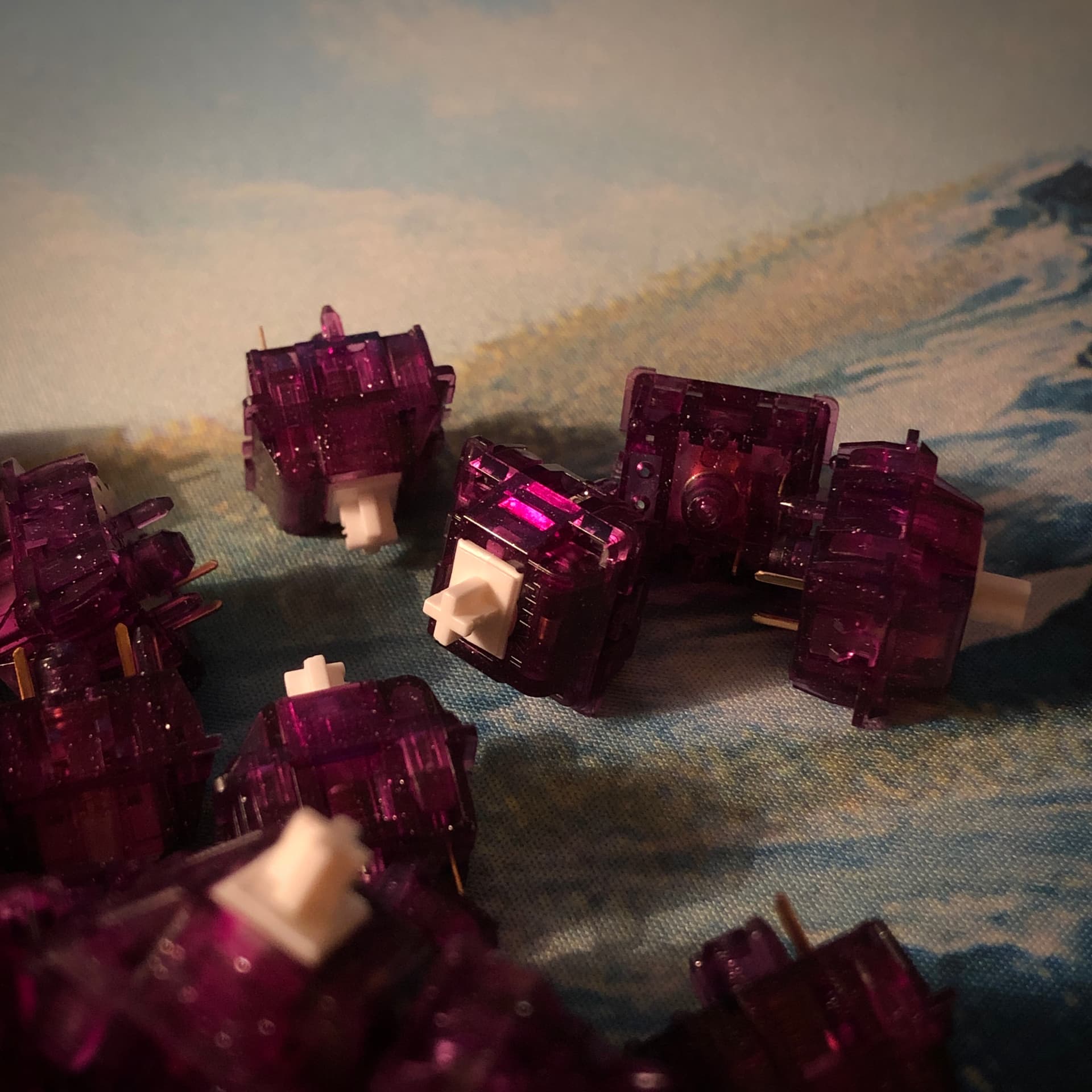
A photo taken in lower, warmer light (and on a Bob Ross deskmat)
Examining the spring found in the final version of the switch, I confirmed that it is not conical, and has the same 3.75mm contact footprint on either end. That is, in theory, flipping the spring shouldn’t have a significant impact on the travel feel. At least when it comes to hard measurable data, there’s slim-to-none supporting the idea that spring orientation matters *unless* the footprint of either end is different from the other. (It probably further depends on how the housing interacts with those footprints; I think it’s easy to imagine some that may tolerate a smaller or larger diameter without changing anything, and others that may seat a smaller coil differently from a larger one.)
Aside from the spring orientation factor, one other significant detail has changed since the IC, and that’s stem material. Originally planned as having a new mold but traditional POM material, the stems are now made of a new-to-switches plastic referred to only as “LY”. As mentioned above, I’ve reached out to Prevail for some more information on this, but so far don’t have much of anything to tell you about it.
A less significant change would be moving from a “milky” plastic look to a clear one for the Nylon housing.
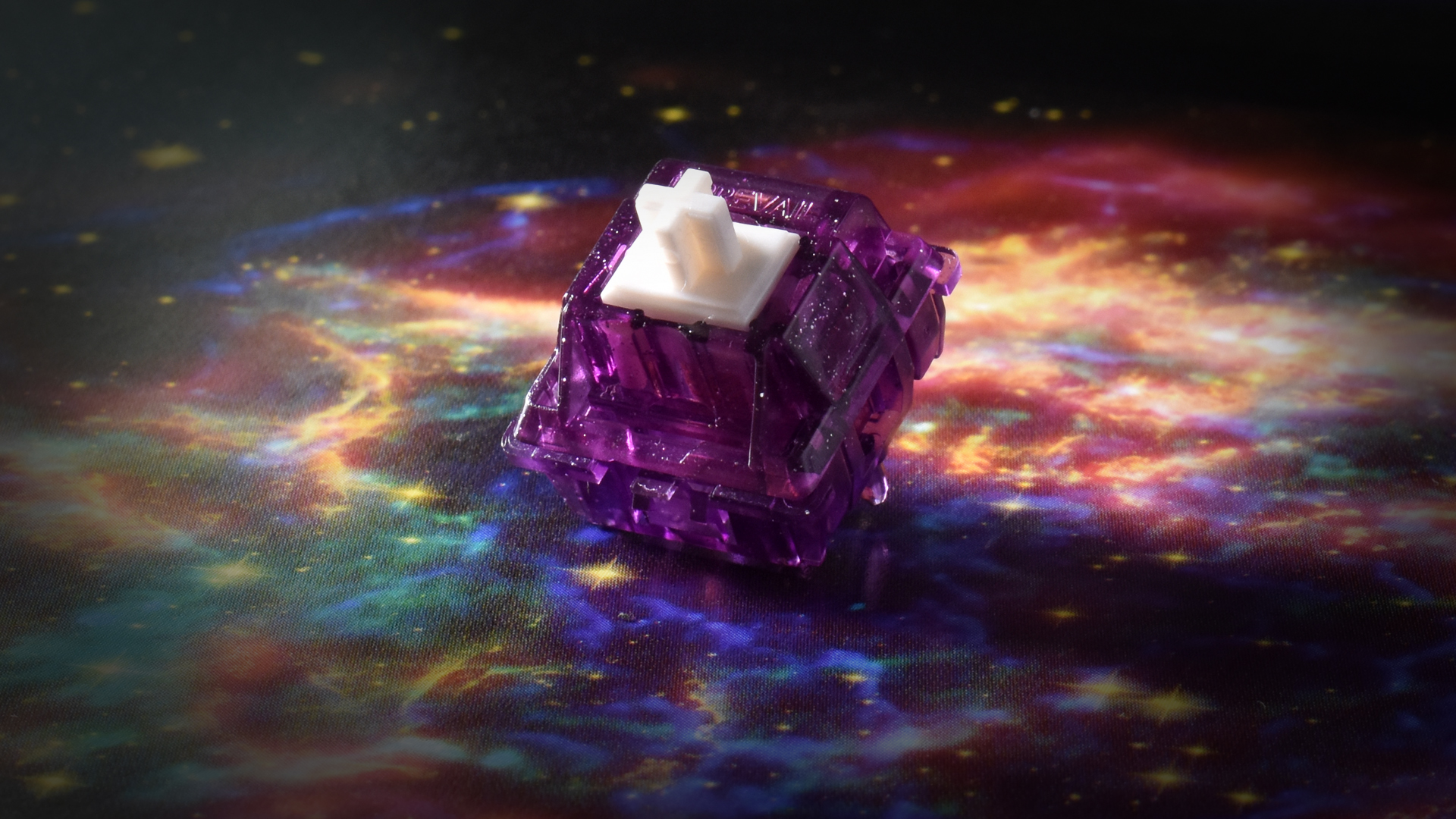
More crystal-y than milky, really.
Alright! It’s time to evaluate these sparkly switches.
Aesthetics:
Whether you caught the IC two years ago or you just happened to see these on Prevail’s website yesterday, the most immediately noticeable thing about these switches is their appearance. While sparkly switches aren’t exactly unheard-of these days, they’re still pretty uncommon – and barely existed at all two years ago. To this day, I’m pretty sure this is the only switch with this particular look: clear purple housing with embedded glitter and an off-white stem.
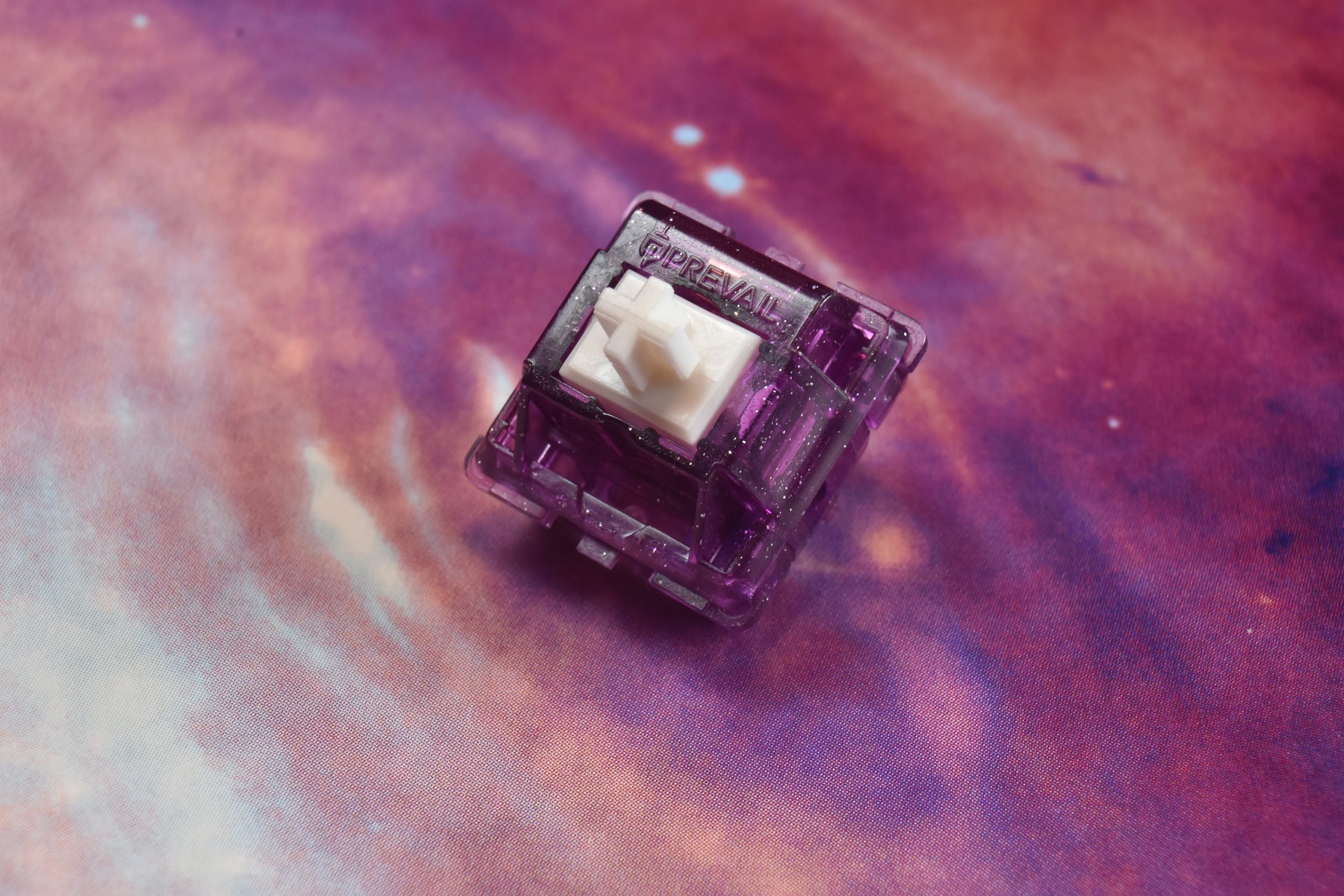
What an opportune time to have a huge coffee-table book about space
In a sea of many, many MX-compatible switches, these manage to stand-out as visually novel – and I think the aesthetic theme is well-executed. Aside from being unusual, I also think they’re striking and pretty. I’m biased, being a huge fan of purple, but I love the color and finish. IMHO, these are some of the nicest-to-look-at switches in my ever-growing collection.
Subjective to personal opinion as it may be, I’d rate the aesthetics of this switch a solid A. They’re fun to look at and at least for now, very distinctive in appearance.
Sound:
If you’ve heard long-pole linears before, these won’t be unfamiliar. In the realm of clacky switches, I would say these are on the mild end when it comes to sound – they’re clacky, not harsh.
For the most part sound is a subjective thing like other aesthetic aspects, but there are some things I focus on when it comes to gauging quality – or at least when it comes to what I enjoy. I like my sounds clean and deliberate. Loud, quiet, sharp, deep – as long as it’s clean. For me, “clean” means an absence of un-intended sound, or sound that in some way signals compromise. Rattle. Tick. Creak. Chatter. Ping! More rattle…
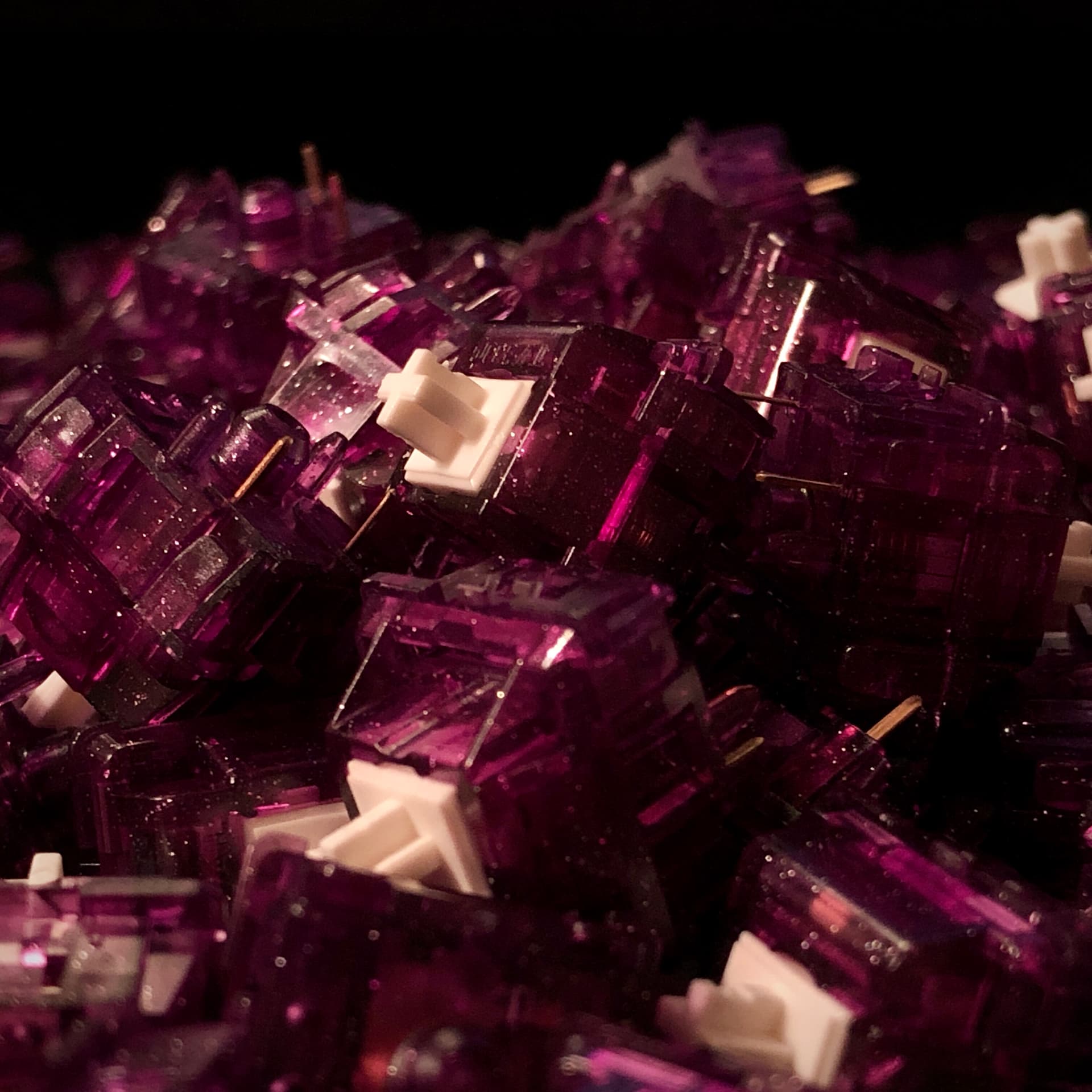
Another photo in low, warm light – helps to illustrate the stem’s not-quite-white-ness.
So are the Nebulae *clean?* Mmmmm they’re alright. The friction surfaces are all more quiet than average – just about silent – but those springs are a little chattery, wiggling around in there like miniature Slinkies. This is something I’ve seen happen *especially* with springs that have tighter coil sections like progressive springs tend to. These have a long section of wide coils that make up most of the travel feel, but they also have a section of much tighter coiling at one end. That part compresses first; other things being equal, the more shallow the angle, the less resistance offered by the coil. The *down-side* of that is those close-together bits of wire are *way* more likely to smack into each-other and make all kinds of messy vibrations than far-apart coils.
Ah, but nothing a little donut-dip in grease or spin in the oil tub can’t fix. So – if you’re liking everything else about this switch, the slinky-springs don’t need to be a deal-breaker. When it comes to my nebulous, arbitrary, mood-dependent scoring system, however, I’ll mainly be focusing on the stock performance. That in mind, I’d give the stock sound experience of the Nebula switches a whelming, fair, and acceptable B-.
Feel:
When discussing the feel of switches, I’ll be breaking that factor down further into Smoothness, Stability, and Weighting.
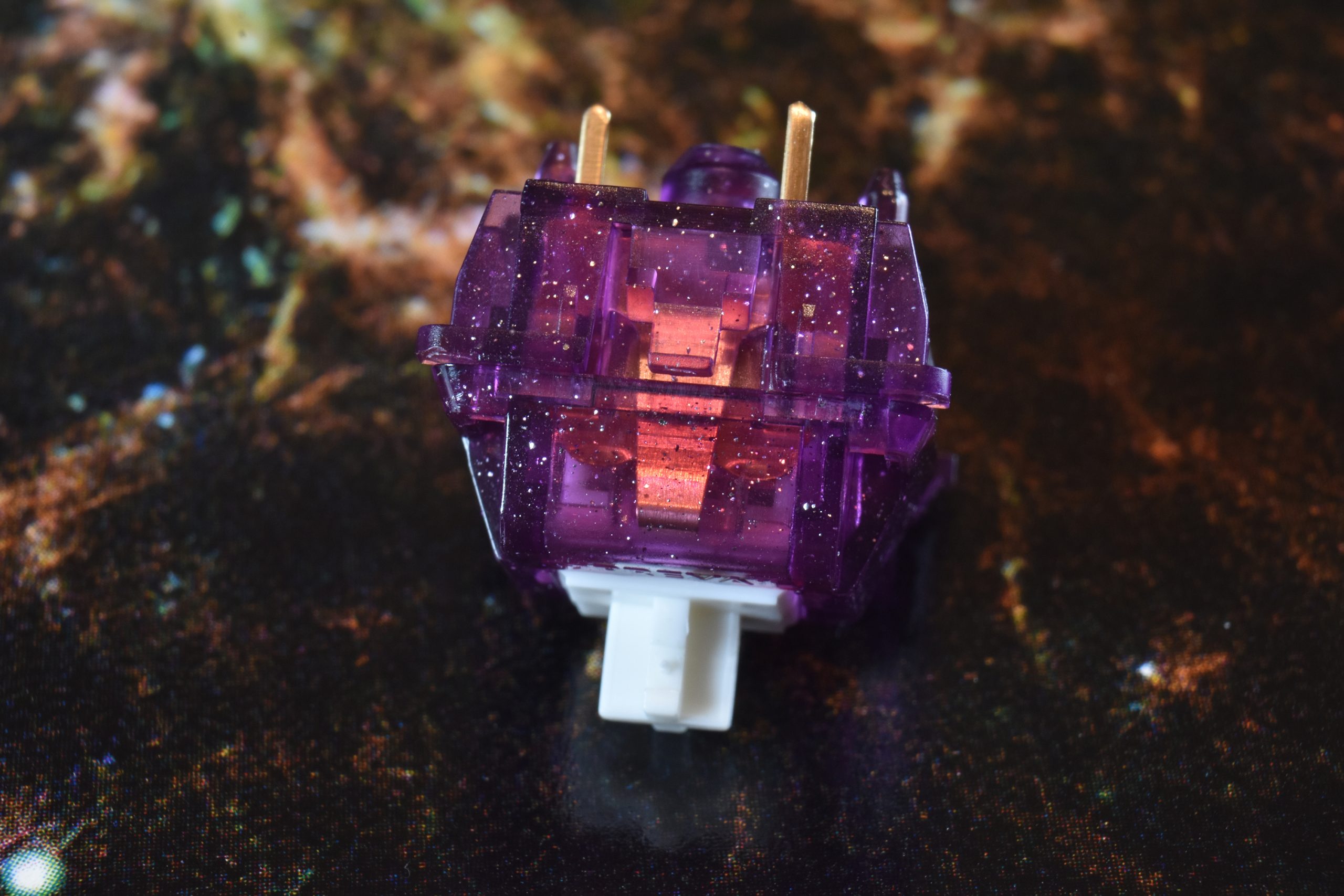
Time for another photo! Here you can see the contact leaf through the glittery housing.
Feel – Smoothness:
When it comes to actually using these switches, the first thing you’re likely to notice about these is that they’re very smooth right from the bag. Even since 2020 this has become a much less rare thing, especially considering this is a JWK-produced switch – but it’s no less important of a factor when it comes to evaluation, and the Nebula switches have it.
Specifically:
- There is very little *if any* perceivable grain in the travel
- The only resistance you feel when typing is from the spring; no binding, no slip-stick, not overly tight
- The feel is consistent throughout travel as well as between switches
Considering only the smoothness aspect of feel, the Nebula switches earn an easy A.
Feel – Stability:
I’ll be breaking this down into a few related factors that come together to give the overall impression of stability in a given switch; resting wobble, bottom wobble, travel stability, and housing fitment. While the last one plays-into and affects the other three, it isn’t the only factor in them, so I kept it as its own point of analysis.
Resting position wobble:
This is how much play exists between the stem and housing when the switch is topped-out, or in its base “off” position – the state it’s in when just sitting on its own, not being pressed-down. This is what most people are referring to when they talk about “wobble”, but I like to distinguish it from some other types.
In the case of the Nebula switches, resting wobble seems pretty average, if perhaps a bit more. When it comes to this factor, they don’t really stand out either way. I’d give them a B- for resting wobble.
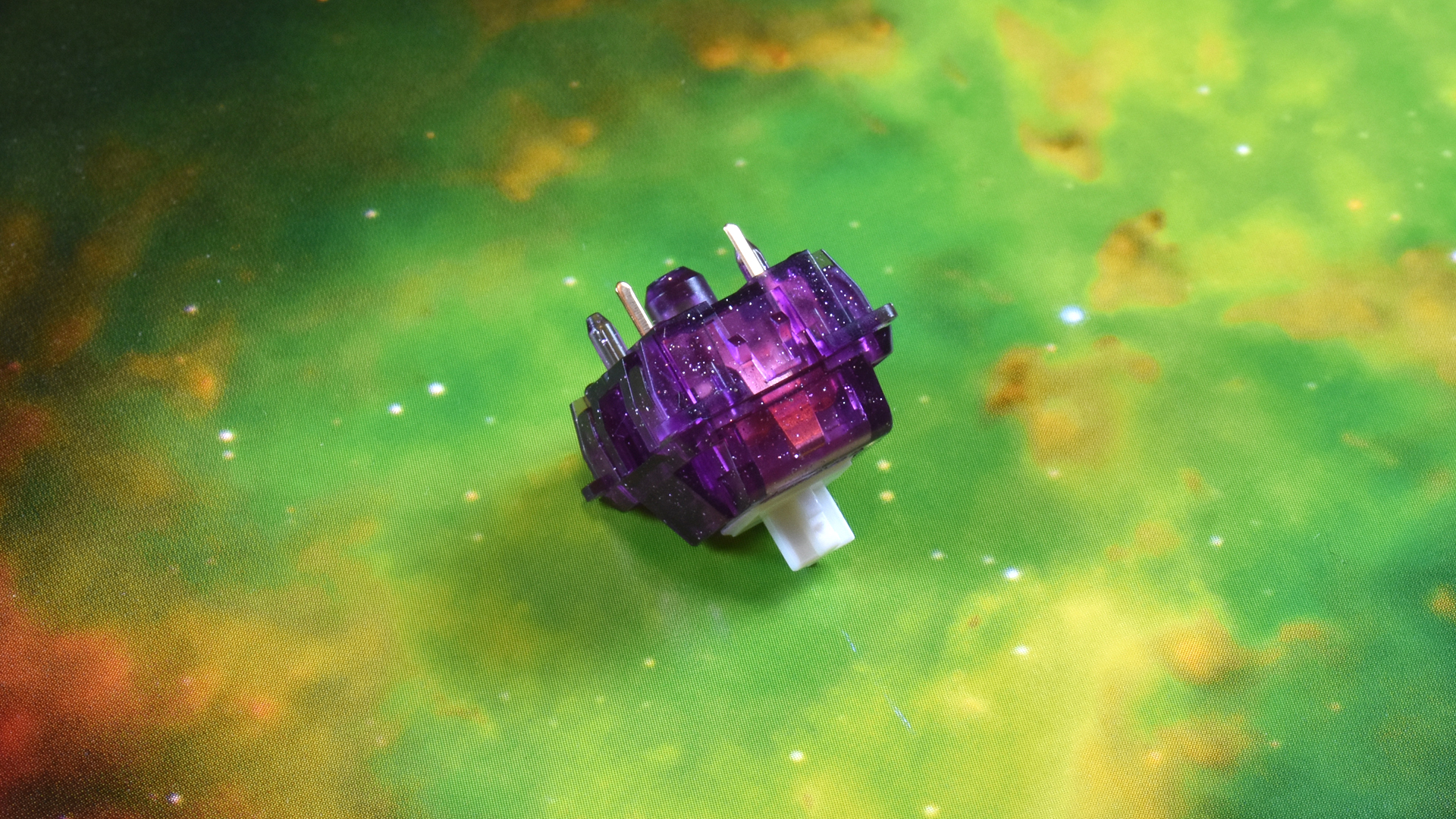
Just so there’s a little more color variety going on here
Bottom position wobble:
This is how much play a stem has within a housing while in the fully-depressed position; when it’s actively being pushed all the way down. In most switches, this is a factor that isn’t often given much attention – but in “long-pole” or otherwise short travel linears like this one, I’ve seen at least a few people cite it as a high-priority data-point. This makes sense, as long-pole switches *generally* have significantly more bottom-wobble than more traditional designs.
Today’s switches are no exception: the bottom-wobble is real. In context of other long-poles, this one doesn’t stand out as being noticeably worse or better – but in a more general context, it’s definitely noticeable when compared to the broader pool of MX-compatible switches.
This is pretty much par for the course when it comes to long-poles and is to be expected; those in the category that *don’t* suffer from this are vanishingly-small in number. For bottom-wobble (and considering its type), I’d give these a dead-average C.
Travel Stability:
At least until I get some measuring equipment, this is a bit more of a subjective factor – but still one I think is very worth discussing when it comes to the feel of a given switch. One might be rock-solid at the top and bottom, but if it feels wiggly all the way down, I’m not going to call it “stable”. When trying to pin this down for yourself, it might help to think of it this way: “when I push this switch down, does the key stay level as if on a flat platform, or does it teeter and wobble as if balancing on a point?”
The last two factors are important to me, but this one nearly eclipses them both when it comes to my personal priorities. If a switch feels “on rails” as it is moving up and down, that makes a very positive impression on me when it comes to perceived quality. So – how are the Nebulae?
Meh? They’re not bad – but they’re not good, either. This may be the Nebula’s weakest performance factor; I’d give them a resoundingly-bleh C- for travel stability.
Housing Fitment:
Not a whole lot to say here – it’s good. So far, none that I’ve opened seem like they need films afterwards, though I’ve heard you can fit especially thin ones in there if you really want to. Another easy A here.
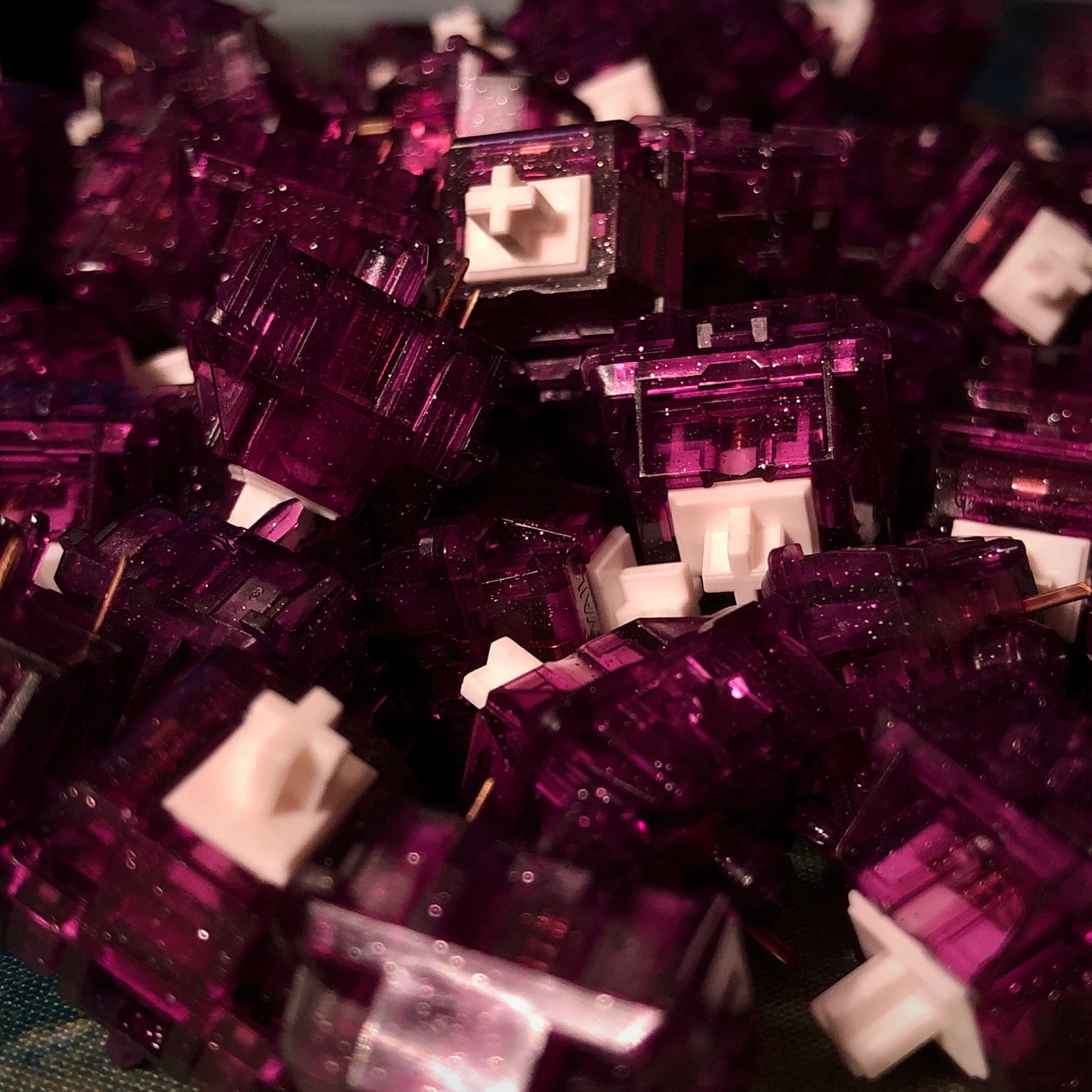
The housings have a good fit. And sparkles.
Cap Fitment:
While not necessarily always a stability factor, this seemed like the most sensible place to talk about the fit between stem and keycap. When excessively loose, this can have a negative impact on the stability and cleanliness of sound and feel. When excessively tight, this can make the switch difficult or impossible to use – and can even damage or destroy keycap stems.
The Nebula’s “LY” stems don’t grip caps as well as the average POM one, but they also do better than plenty of UHMWPE stems. When using a GMK cap, for example, the fitment seems pretty normal – but with one of my PBT sets, it’s noticeably easier than average to install and remove caps from the stems.
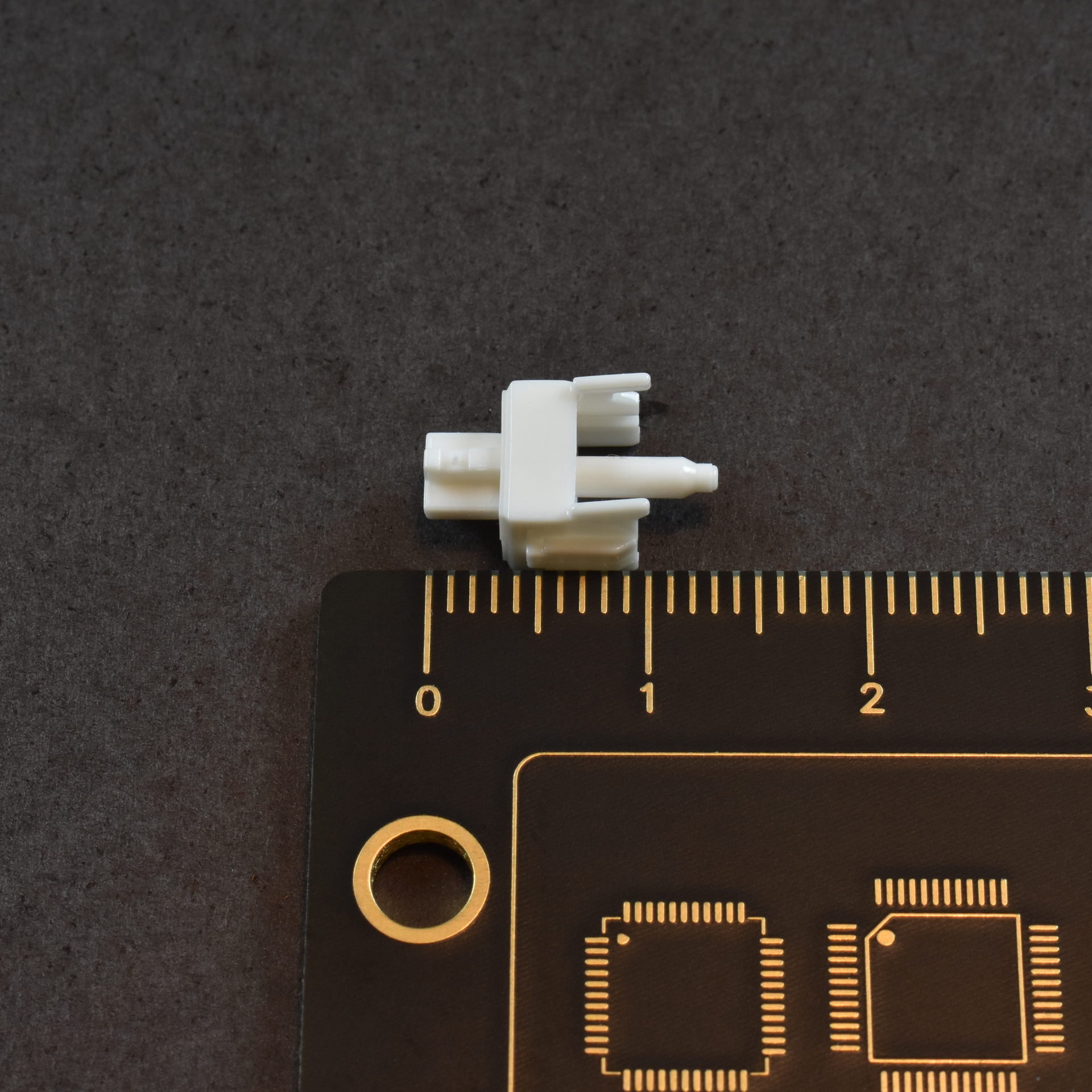
A look at the LY stem and its tapered long pole; overall length appears to be about 13.5mm.
They aren’t so loose that I’d consider it a problem, and I don’t expect any but the most loose of caps to have any trouble staying on and in-position, but I still thought it worth mentioning that these have a less-tight-than-average grip with cap stems. When it comes to cap fitment, I’d give the Nebula switches a roughly-average C. (It might actually be a little more loose than average, but since I didn’t observe any actual issues with any caps I tried on them, I see no reason to rate this any lower.)
All of that considered, I’d give the Nebula switches a flat C when it comes to overall stability.
Feel – Weighting:
So, how does that weird-looking spring feel?
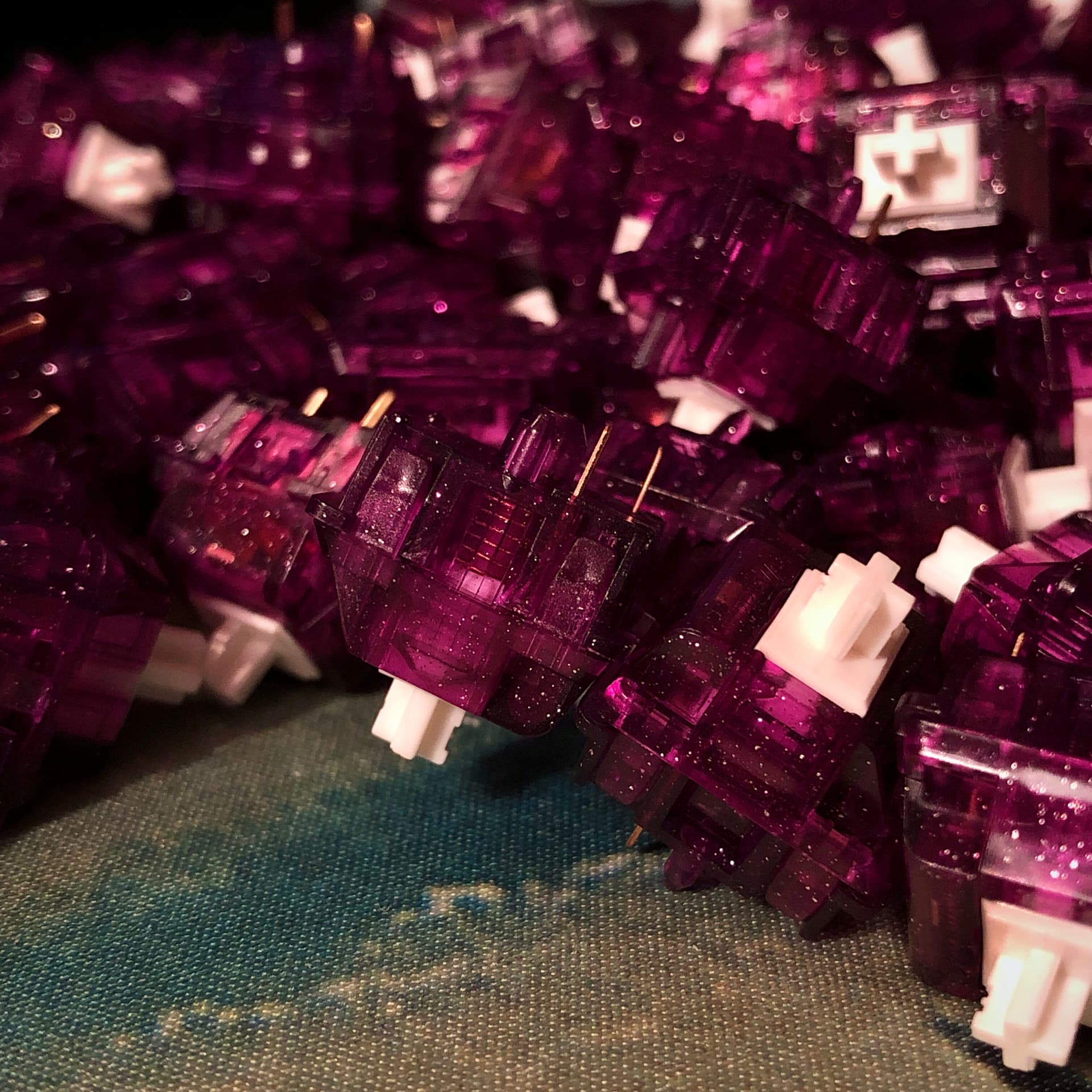
The spring, as seen through the transparent housing
I’d say I get the most out of them with a medium-light typing style. They’ll tolerate slammy-whammy typing just fine, but their nuance comes out somewhere between that and twinkle-toeing your way along the keys – and you’ll get less slinky-chatter that way, too.
Now – I don’t have a force-curve-graph device – yet – but I’ll do my best to describe my subjective experience of these.
Over well before actuation happens, the first tiny bit of travel is like a light, gentle pillow. Behind that, it feels like a slow-curve linear the rest of the way down to me, perhaps with a mild ramping-up more towards the bottom. On the way back up, that mostly-slow-curve linear action gives you a nice, lively alley-oop – but instead of a follow-through that smacks the stem into a wall, it mellows to the gentle shove of an ice curling champion right at the end.
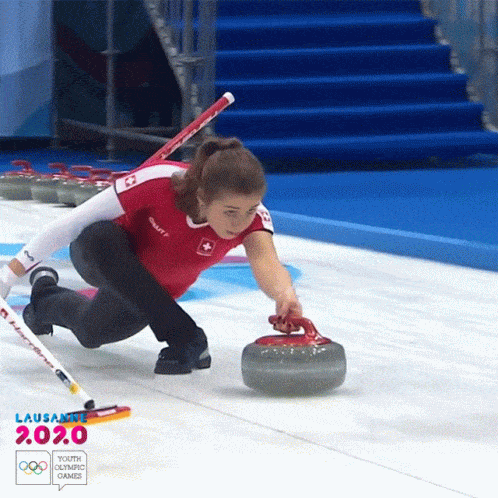
Easy does it…
Colorful hyperbole aside, the spring manages to impart something of a “bouncy” feel without an aggressive fast curve. Slightly more marshmallow-y than Marshmallows? Maybe. Look, using words to describe springs is hard ok
Is it going to blow your mind with its novel force-curve? No. Is it pleasant to use and a bit more interesting than yellows / reds / blacks? Yes. It’s also more smooth than most chromonymous switches, too. Yes, I just made that word up – but hey, that’s language for ya
When it comes to the spring feel, I think Nebulae get an A, eh? Ay!
Reliability & Caveats:
This is a section where I talk about functional reliability, and consolidate any other caveats that may have come up in any other sections into a list of suggestions for potential improvement.
Functional Reliability:
When it comes to functional reliability, there’s only a few things that can go wrong – and generally speaking, you’re looking at either occasional missed inputs or occasional unintended repeat inputs, also called “chatter”. Other potential caveats may include manufacturing inconsistencies, material durability issues, or significant fitment problems. So – how reliable are the Nebula switches?
Reasonably – but not completely.
*Every now and then* – just often enough to stop questioning if it’s a fluke – the Nebulae will chatter. That is, on rare occasions, pressing a key once will send the signal twice – and you’ll end up with an extra letter or number on-screen. This is rare enough that I don’t count it as a significant detractor – but just frequent enough that I feel ignoring it would be disingenuous.
Said another way, I’ve been using these switches every day for a few weeks, often for many hours each day. During that time, I think the most I’ve seen chatter in a single day is three instances. Some days I don’t see any at all. Most I’ll see one or two. I’d call these reasonably reliable – but if reliable function is critical, I’d look elsewhere. I’d give Nebulae the subjective score of B- when it comes to functional reliability.
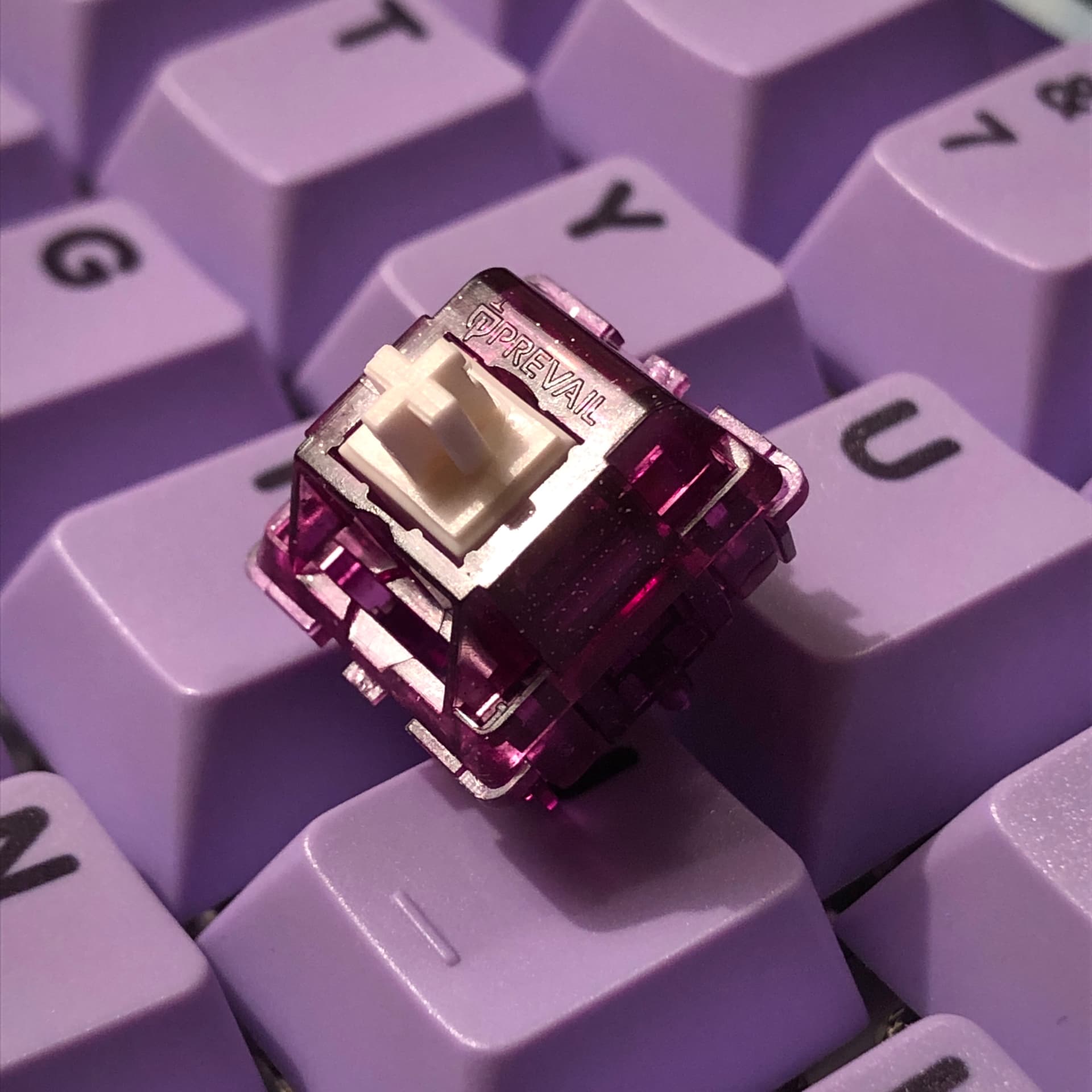
Low-light photo with the switch sitting on NovelKeys’ PBT Taro
Other Caveats:
When it comes to detractors for this switch, they’re pretty much all centered around the stem and housing having fairly loose tolerance with each-other, and around the noisy spring. (To JWK’s credit: In my experience, tuning audible noise out of progressive springs is a bit more challenging than with standard ones.)
So, a list of caveats for this switch would be:
- Less than perfect functional reliability: some electrical chatter —> extra inputs
- Not all that stable
- Sound isn’t clean
- Might be a little loose depending on your caps
Suggestions for improvement:
Were I to be in charge of a round two for these switches here’s what I would set out to change:
- Inspect closely the operation of the contacts and see if anything can be done about the occasional electrical chatter
- Adjust the new stem mold to produce an ever-so-slightly larger stem
- If at all practical, include a process in the factory lubrication that involves the spring; both ends dipped in grease or the whole thing soaked in oil – either should take the edge off of these talkative springs
When it comes to overall caveats, how do these measure up? I’d give Nebulae a solid B when it comes to necessary compromise.
Value:
Here’s where it all comes together. We know what the switch is about and how successful it is in reaching its stated goals – but how much does it cost, and is it worth it?
Coming in at ten cents under the target price settled-on at the end of the IC, Prevail Nebulae come in at a very reasonable ~$0.65 per switch. This puts them on the high side of average, and for a switch that performs as well as this one does right from the bag, I think it’s spot-on. At least on Prevail’s website, Nebula switches are offered in packs of 70, 90, and 110 – not the packs-of-ten they’d originally planned on, but a reasonable enough breakdown.
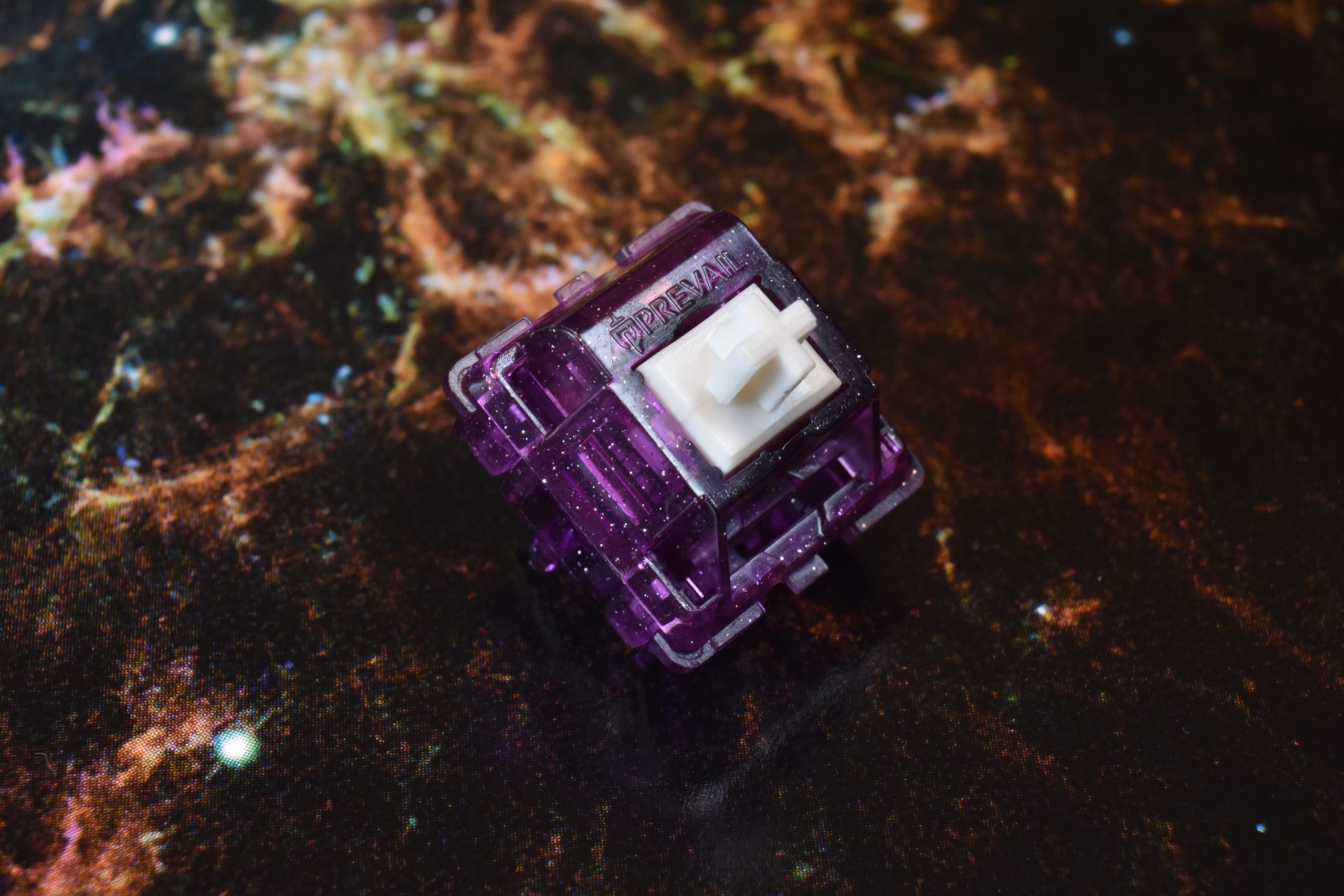
A nice look at the “Prevail” badge.
Cleanliness of sound and degree of wobble are the only real weaknesses here IMO, and they aren’t too bad in that regard – just not impressive like their Epsilon siblings. So, while these may not be quite the “must have” I consider those to be, I don’t have any misgivings about calling Nebula switches a solid value.
If stability or stock cleanliness is a high priority for you, I don’t think these will satisfy – but if you hold smoothness or a nuanced spring character above those, I recommend including Prevail Nebulae among your considerations. They are unfalteringly smooth, pleasantly clacky, and offer a haptic experience a bit more nuanced than the average bear (or Panda, or Alpaca…) – When it comes to overall value, I’m happy to award Prevail Nebula switches a healthy A-.
Quick subjective score recap:
Aesthetics: A
Sound: B-
Smoothness: A
Overall Stability: C
Housing Fitment: A
Cap Fitment: C
Spring Feel: A
Reliability: B-
Compromise: B
Value: A-
Overall subjective score: B+
While I wasn’t as impressed with these as I was with Epsilons, hey – those are a hard act to follow. None the less, these Nebulae have their own nuanced experience to offer, and I’d recommend them for folks who want to see what the progressive business is about. If you’re looking to treat your fingers with some soft, spacey clacks, well – you could do a whole lot worse than these – and there’s really nothing else out there right now that looks quite like them.
Alright! That’s all I have to say about Prevail’s Nebula switch for today – thanks so much for reading, and have a good one.

